Discover 25 hidden attractions, cool sights, and unusual things to do in Nepal. Don't miss out on these must-see attractions: Pashupatinath Temple (Kathmandu), Swayambhunath (Kathmandu) or Kathmandu Durbar Square (Kathmandu).
Below, you can find the list of the most amazing places you should visit in Nepal.
Table of Contents
Pashupatinath Temple, Kathmandu

Also known as: पशुपतिनाथ मन्दिर
Revered, historic Hindu temple. Pashupatinath Temple is a Hindu temple dedicated to Pashupati, and is located in Kathmandu, Nepal.
This temple was classified as a World Heritage Site in 1979. This "extensive Hindu temple precinct" is a "sprawling collection of temples, ashrams, images and inscriptions raised over the centuries along the banks of the sacred Bagmati river", and is one of seven monument groups in UNESCO's designation of Kathmandu Valley.
The temple is one of the Paadal Petra Sthalams on the continent.[1]
Address: Pashupati Nath Road 44621, 44600 Kathmandu
Swayambhunath, Kathmandu
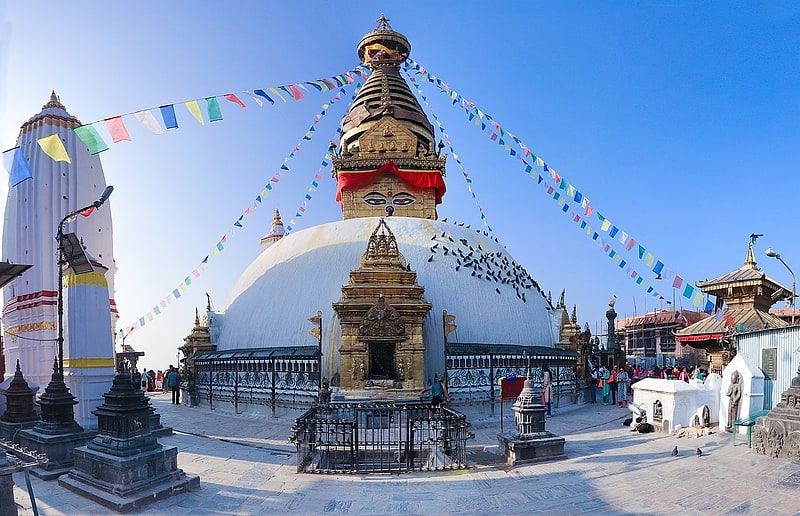
Also known as: स्वयम्भूनाथ
Storied temple complex and pilgrimage site. Swayambhu is an ancient religious complex atop a hill in the Kathmandu Valley, west of Kathmandu city. The Tibetan name for the site means 'Sublime Trees', for the many varieties of trees found on the hill. However, Shing.kun may be of the local Nepal Bhasa name for the complex, Swayambhu, meaning 'self-sprung'. For the Buddhist Newars, in whose mythological history and origin myth as well as day-to-day religious practice Swayambhunath occupies a central position, it is probably the most sacred among Buddhist pilgrimage sites. For Tibetans and followers of Tibetan Buddhism, it is second only to Boudha. Swayambhunath is the Hindu name.
The complex consists of a stupa, a variety of shrines and temples, some dating back to the Licchavi period. A Tibetan monastery, museum and library are more recent additions. The stupa has Buddha's eyes and eyebrows painted on. Between them, the number one (in Devanagari script) is painted in the fashion of a nose. There are also shops, restaurants and hostels. The site has two access points: a long staircase leading directly to the main platform of the temple, which is from the top of the hill to the east; and a car road around the hill from the south leading to the south-west entrance. The first sight on reaching the top of the stairway is the Vajra. Tsultrim Allione describes the experience:
We were breathless and sweating as we stumbled up the last steep steps and practically fell upon the biggest vajra (thunderbolt scepter) that I have ever seen. Behind this Vajra was the vast, round, white dome of the stupa, like a full solid skirt, at the top of which were two giant Buddha eyes wisely looking out over the peaceful valley which was just beginning to come alive.
Much of Swayambhunath's iconography comes from the Vajrayana tradition of Newar Buddhism. However, the complex is an important site for Buddhists of many schools, and is also revered by Hindus.[2]
Address: Swayamhu Circle Road, 44620 Kathmandu
Kathmandu Durbar Square, Kathmandu
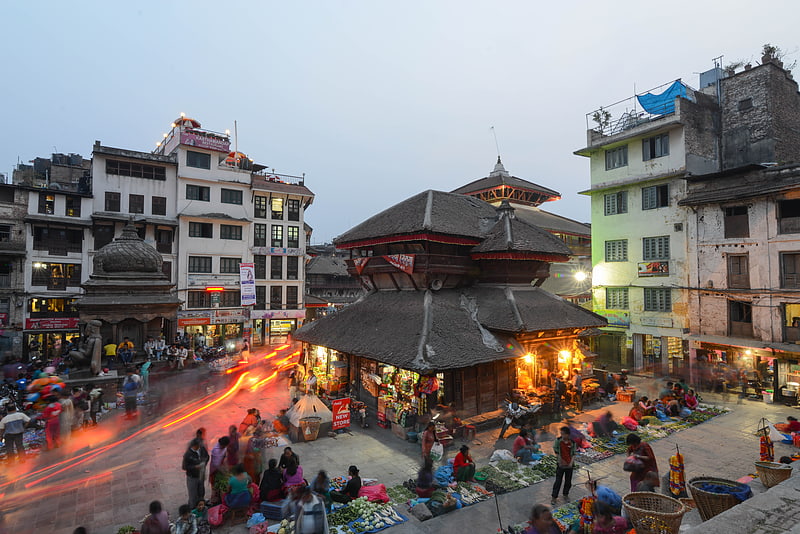
Also known as: वसन्तपुर दरबार क्षेत्र
Historical landmark in Kathmandu, Nepal. Kathmandu Durbar Square in front of the old royal palace of the former Kathmandu Kingdom is one of three Durbar Squares in the Kathmandu Valley in Nepal, all of which are UNESCO World Heritage Sites.
Several buildings in the Square collapsed due to a major earthquake on 25 April 2015. Durbar Square was surrounded with spectacular architecture and vividly showcases the skills of the Newar artists and craftsmen over several centuries. The Royal Palace was originally at Dattaraya square and was later moved to the Durbar square.
The Kathmandu Durbar Square held the palaces of the Malla and Shah kings who ruled over the city. Along with these palaces, the square surrounds quadrangles, revealing courtyards and temples. It is known as Hanuman Dhoka Durbar Square, a name derived from a statue of Hanuman, the monkey devotee of Lord Ram, at the entrance of the palace.[3]
Address: Ganga Path, 44600 Kathamndu
Kala Patthar, Mount Everest
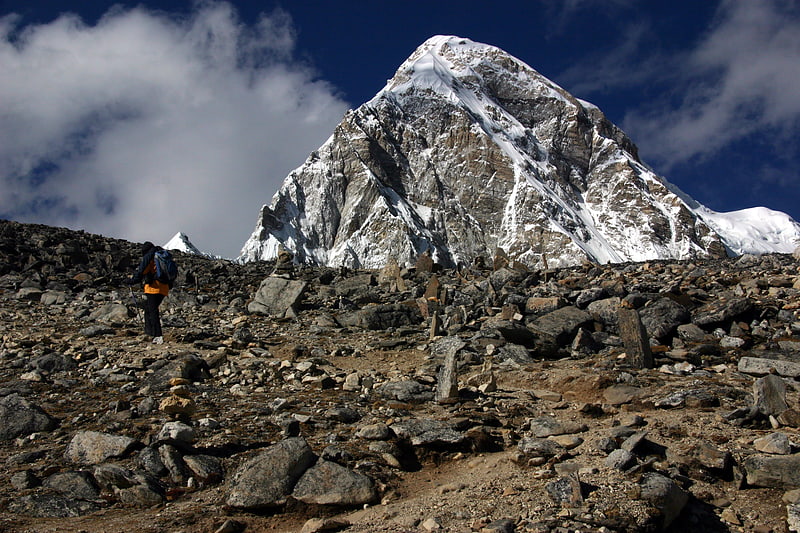
Peak for views of Mount Everest. Kala Patthar is a notable landmark located on the south ridge of Pumori in the Nepali Himalayas above Gorakshep. Although not a proper mountain, with a prominence of only 10 m, the ascent of Kala Patthar is very popular with trekkers in the region of Mount Everest since it provides the most accessible closeup view of Everest. Due to the structure of the Everest Massif, its high summit is blocked by Nuptse from much of the surrounding region. The views of Everest, Nuptse and Changtse are spectacular from Kala Patthar and there are glimpses of the northern flank and summit of Lhotse. The world's highest webcam, Mount Everest webcam, was located here. Kala Patthar is considered the highest altitude most will reach without a climbing permit, which must be obtained in Kathmandu, at the Nepal Mountaineering Association.[4]
Gupteshwor Mahadev Cave, Pokhara
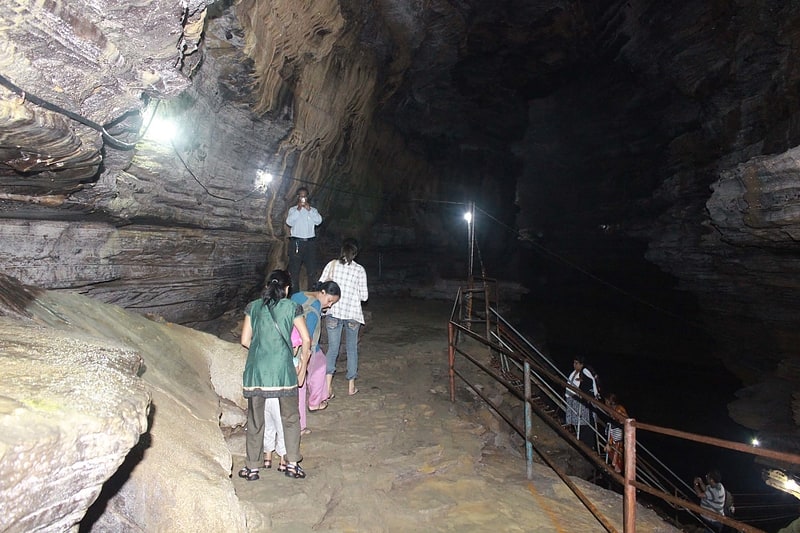
Tourist attraction in Pokhara, Nepal. Gupteshwor Mahadev Cave is a cave located in Pokhara-17,Chhorepatan, Kaski district, opposite to Davis Fall, the water from Davis fall passes through this cave. Gupteshwor Mahadev cave is one of the major attractions of Pokhara.[5]
Address: Gupteshwor Mahadev Cave, Pokhara
Cho Oyu, Sagarmatha National Park
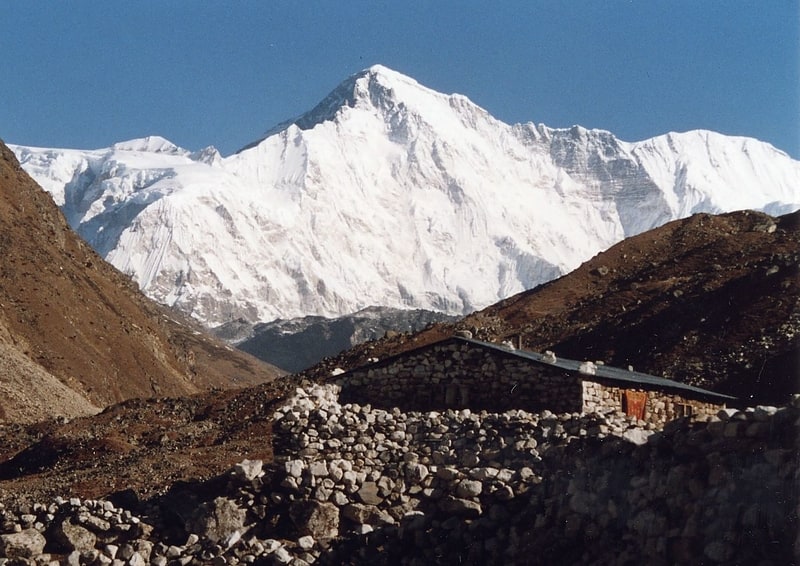
Also known as: चोयु हिमाल
Mountain in Asia. Cho Oyu is the sixth-highest mountain in the world at 8,188 metres above sea level. Cho Oyu means "Turquoise Goddess" in Tibetan. The mountain is the westernmost major peak of the Khumbu sub-section of the Mahalangur Himalaya 20 km west of Mount Everest. The mountain stands on the China–Nepal border.
Just a few kilometres west of Cho Oyu is Nangpa La (5,716m/18,753 ft), a glaciated pass that serves as the main trading route between the Tibetans and the Khumbu's Sherpas. This pass separates the Khumbu and Rolwaling Himalayas. Due to its proximity to this pass and the generally moderate slopes of the standard northwest ridge route, Cho Oyu is considered the easiest 8,000 metre peak to climb. It is a popular objective for professionally guided parties.[6]
Gokyo Lakes, Sagarmatha National Park
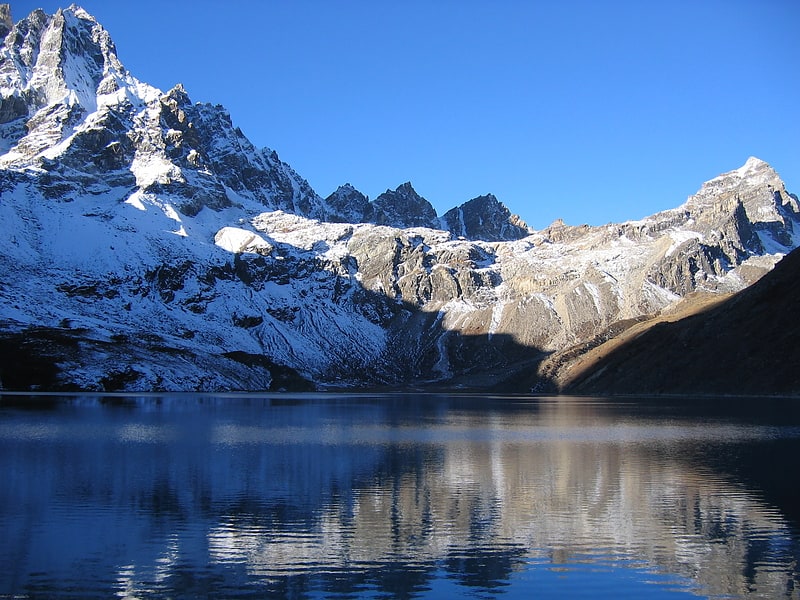
Also known as: गोक्यो ताल
Lake in Nepal. Gokyo Lakes are oligotrophic lakes in Nepal's Sagarmatha National Park, located at an altitude of 4,700–5,000 m above sea level. Lakes and resort were named after Gokyo Ri peak. These lakes are the world's highest freshwater lake system comprising six main lakes, of which Thonak Lake is the largest. In September 2007, Gokyo and associated wetlands of 7,770 ha have been designated a Ramsar site.[7]
Imja Tse, Sagarmatha National Park
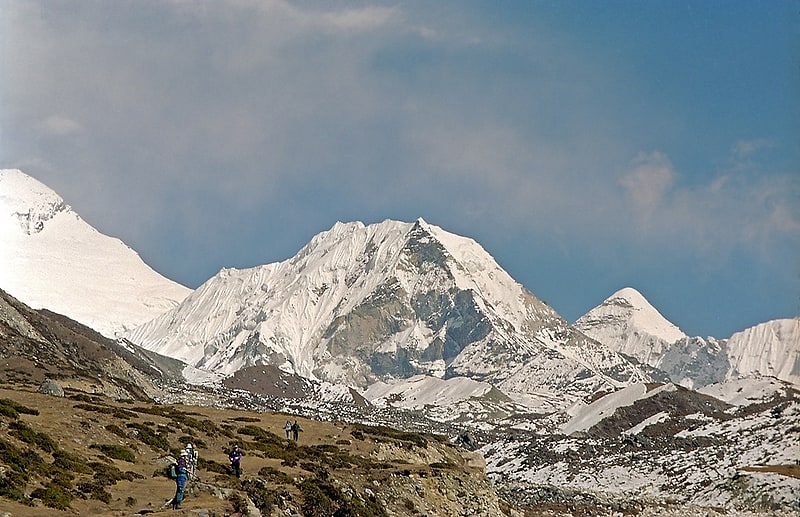
Mountain in Nepal. Imja Tse, better known as Island Peak, is a mountain in Sagarmatha National Park of the Himalayas of eastern Nepal. The peak was named Island Peak in 1953 by members of the British Mount Everest expedition because it appears as an island in a sea of ice when viewed from Dingboche. The peak was later renamed in 1983 to Imja Tse but Island Peak remains the popular choice. The peak is actually an extension of the ridge coming down off the south end of Lhotse Shar.
The southwest summit of Imja Tse was first climbed in 1953 as part of a training exercise by a British expedition that went on to summit Mount Everest. The team who climbed Imja Tse comprised Tenzing Norgay, Charles Evans, Alfred Gregory, Charles Wylie and seven other Sherpas. The main summit was first climbed in 1956 by Hans-Rudolf Von Gunten and two unknown Sherpas, members of a Swiss team that went on to make the second ascent of Everest and first ascent of Lhotse.[8]
Patan Durbar Square, Patan
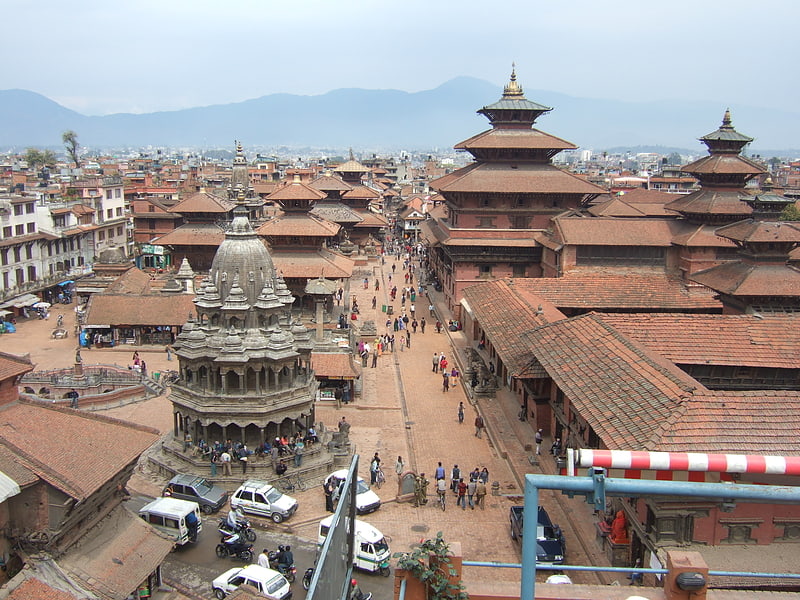
Also known as: पाटन दरवार क्षेत्र
Historical landmark in Patan, Nepal. Patan Durbar Square is situated at the centre of the city of Lalitpur in Nepal. It is one of the three Durbar Squares in the Kathmandu Valley, all of which are UNESCO World Heritage Sites. One of its attractions is the ancient royal palace where the Malla Kings of Lalitpur resided.
The Durbar Square is a marvel of Newar architecture. The square floor is tiled with red bricks. There are many temples and idols in the area. The main temples are aligned opposite of the western face of the palace. The entrance of the temples faces east, towards the palace. There is also a bell situated in the alignment beside the main temples. The Square also holds old Newari residential houses. There are other temples and structures in and around Patan Durbar Square built by the Newa People. A center of both Hinduism and Buddhism, Patan Durbar Square has 136 "bahals" (courtyards) and 55 major temples.
The square was heavily damaged by the earthquake in April 2015.[9]
Pumori, Mount Everest
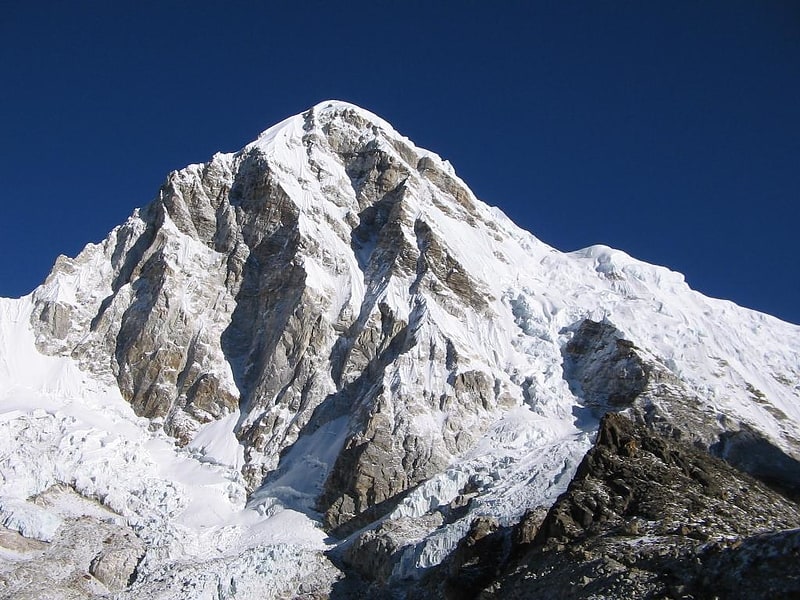
Also known as: पुमोरी
Mountain in Nepal. Pumori is a mountain on the Nepal-China border in the Mahalangur section of the Himalayas. Pumori lies just eight kilometres west of Mount Everest. Pumori, meaning "the Mountain Daughter" in Sherpa language, was named by George Mallory. "Pumo" means young girl or daughter and "Ri" means mountain in Sherpa language. Climbers sometimes refer to Pumori as "Everest's Daughter". Mallory also called it Clare Peak, after his daughter.
Pumori is a popular climbing peak. The easiest route is graded class 3, although with significant avalanche danger. Pumori was first climbed on May 17, 1962, by Gerhard Lenser on a German-Swiss expedition. Two Czechs (Leopold Sulovský and Zdeněk Michalec) climbed a new route on the south face in the spring of 1996.
An outlier of Pumori is Kala Patthar (5,643 metres, 18,514 ft), which appears as a brown bump below the south face of Pumori. Many trekkers going to see Mount Everest up close will attempt to climb to the top of Kala Patthar.[10]
Bat Cave, Pokhara
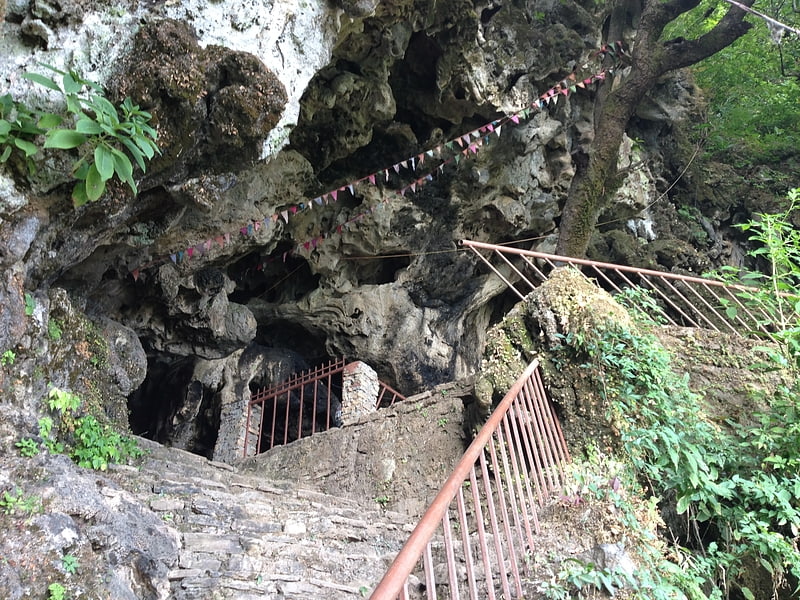
Tourist attraction in Pokhara, Nepal. The Bat Cave is a solutional cave in the Kaski District in Pokhara, Nepal. It is known for a habitat of Horseshoe bats inside the cave, over the walls and ceiling. The cave is formed of limestone. It is a show cave and one of the most popular tourist destinations in Pokhara.[11]
Ratna Mandir, Pokhara

Historical landmark in Pokhara, Nepal. Ratna Mandir is a former palace used by the Nepalese royal family.
It is located near the Phewa Lake in Pokhara, Gandaki Province, Nepal. Ratna Mandir was built in 1956 by King Mahendra for his wife Ratna, and the palace is spread over 56,468 square meters.[12]
Bhaktapur Durbar Square, Bhaktapur
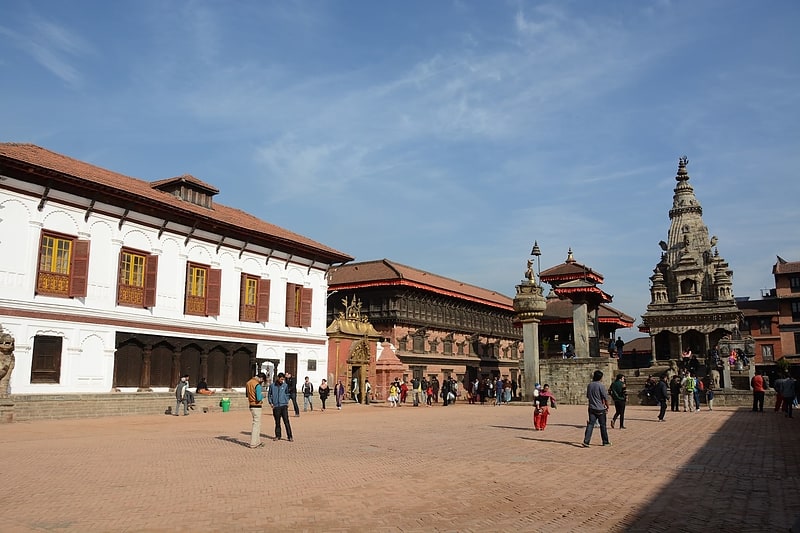
Also known as: भक्तपुर दरवार क्षेत्र
Tourist attraction in Bhaktapur, Nepal. Bhaktapur Durbar Square, locally known as Khwopa Lyaku is the royal palace of the old Bhaktapur Kingdom, 1,400 metres above sea level. It is a UNESCO World Heritage Site. Reasonably, it is grounded within the area of 6.52 square miles yet it has numerous temples and wow monuments.
The Bhaktapur Durbar Square is located in the current town of Bhaktapur, also known as Khwopa, which lies 13 km east of Kathmandu. While the complex consists of at least four distinct squares (Durbar Square, Taumadhi Square, Dattatreya Square and Pottery Square), the whole area is informally known as the Bhaktapur Durbar Square and is a highly visited site in the Kathmandu Valley
Detailed information and pictures can be found in : https:www.bhaktapur.com/[13]
Address: Durbar Square, Bhaktapur
Nuptse, Mount Everest
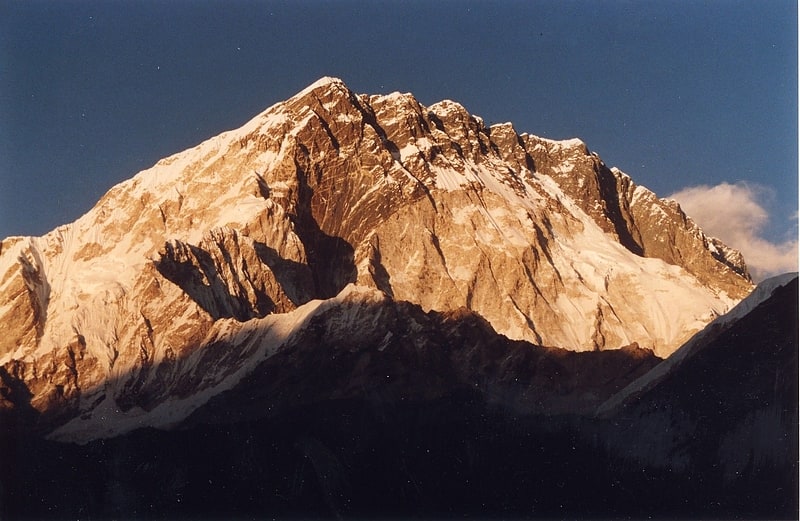
Also known as: नुबचे
Mountain in Nepal. Nuptse or Nubtse is a mountain in the Khumbu region of the Mahalangur Himal, in the Nepalese Himalayas. It lies two kilometres WSW of Mount Everest. Nubtse is Tibetan for "west peak", as it is the western segment of the Lhotse-Nubtse massif.
The main peak, Nubtse I, was first climbed on May 16, 1961 by Dennis Davis and Sherpa Tashi and the following day by Chris Bonington, Les Brown, James Swallow and Pemba Sherpa, members of a British expedition led by Joe Walmsley. After a long hiatus, Nubtse again became the objective of high-standard mountaineers in the 1990s and 2000s, with important routes being put up on its west, south, and north faces.
While Nubtse is a dramatic peak when viewed from the south or west, and it towers above the base camp for the standard south col route on Everest, it is not a particularly independent peak: its topographic prominence is only 319 m (1,047 ft). Hence it is not ranked on the list of highest mountains.[14]
Gosaikunda, Langtang National Park
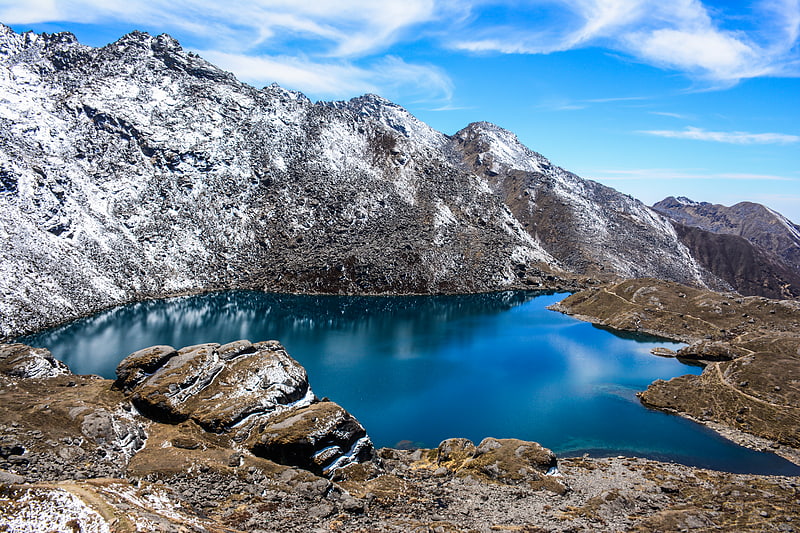
Also known as: गोसाइँकुण्ड
Lake in Nepal. Gosaikunda, also spelled Gosainkunda and Gosain Kunda, is an alpine freshwater oligotrophic lake in Nepal's Langtang National Park, located at an elevation of 4,380 m in the Rasuwa District with a surface of 13.8 ha. Together with associated lakes, the Gosaikunda Lake complex comprises 1,030 ha in size and was designated a Ramsar site on 29 September 2007.
The lake melts to form the Trishuli River; it remains frozen for six months in winter October to June. There are 108 lakes in the vicinity. The Lauribina La pass at an elevation of 4,610 m (15,120 ft) is on its outskirts.[15]
Tusha Hiti, Patan
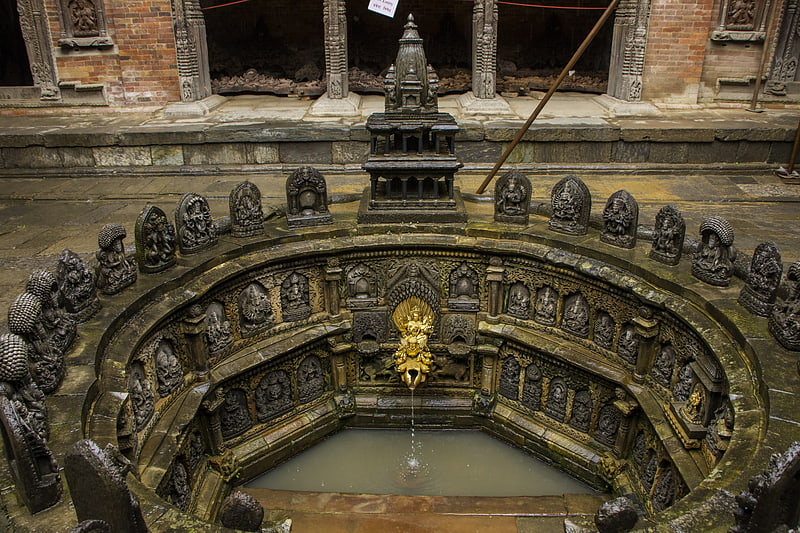
The Tusha Hiti, also known as Royal Bath, is a sunken bath used by the Malla royal family in Nepal. It is at the courtyard of Sundari Chowk, Patan Durbar Square, Lalitpur. King Siddhinarasimha Malla is credited with building the bath in the 17th century. The wall features idols of Ashta Matrikas, eight Bhariavs and Nagas, and the gilt copper spout features idols of Vishnu and Laxmi residing on Garuda. The Tusha Hiti is shaped like a yoni and can be accessed via its main entrance from the western façade.[16]
Krishna Mandir, Patan
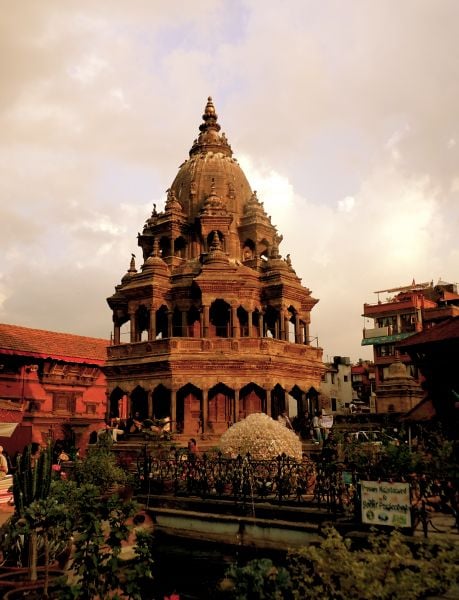
Hindu temple in Patan, Nepal. Krishna Mandir is a 17th-century Shikhara-style temple built by King Siddhi Narsing Malla. It is located at the Patan Durbar Square, a UNESCO World Heritage Site. It was damaged by the Nepal earthquake of April 2015, and was later restored in 2018.[17]
Address: Mangal Bazaar, Patan
Suryavinayak Temple, Bhaktapur

Suryavinayak Temple is a Hindu Temple in Nepal. It is located in Bhaktapur district, Nepal. The temple is dedicated to the Hindu god Ganesh. The temple is an historical and cultural monument and tourist centre. The Suryavinayak Temple is one of the four popular shrines of Lord Ganesh in the Kathmandu Valley. The temple is also known as the temple of the rising sun.[18]
Langtang Lirung, Langtang National Park
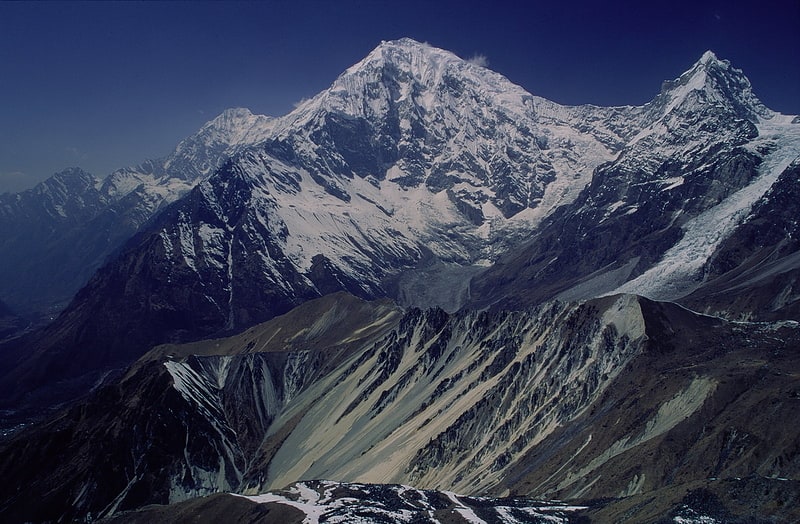
Also known as: लाङटाङ लिरुङ
Peak in Nepal. Langtang Lirung is the highest peak of the Langtang Himal, which is a subrange of the Nepalese Himalayas, southwest of the Eight-thousander Shishapangma. The List of the world's highest 100 mountains puts it at number 99.[19]
Dorje Lhakpa, Langtang National Park

Mountain in Nepal. Dorje Lhakpa is a mountain in the Jugal Himal, southeast of Langtang valley in Nepal.
Visible also from Kathmandu valley it has an elegant pyramid-shaped figure and is an ideal target for photographers and mountaineers. Considered by many of intermediate difficulty with easiest route from the west ridge. Its climb is offered by many trekking and mountaineering agencies in Nepal.[20]
Annapurna, Annapurna Conservation Area

Also known as: अन्नपूर्ण हिमाल
Mountain range in Nepal. Annapurna is a mountain situated in the Annapurna mountain range of Gandaki Province, north-central Nepal. It is the tenth highest mountain in the world at 8,091 metres above sea level and is well known for the difficulty and danger involved in its ascent.
Maurice Herzog led a French expedition to its summit through the north face in 1950, making it the first eight-thousand meter peak ever successfully climbed. The entire massif and surrounding area are protected within the 7,629-square-kilometre (2,946 sq mi) Annapurna Conservation Area, the first and largest conservation area in Nepal. The Annapurna Conservation Area is home to several world-class treks, including Annapurna Sanctuary and Annapurna Circuit.
For decades, Annapurna I Main held the highest fatality-to-summit rate of all principal eight-thousander summits; it has, however, seen great climbing successes in recent years, with the fatality rate falling from 32% to just under 20% from 2012 to 2022. This figure places it just under the most recent fatality rate estimates for K2, at about 24%. The mountain still poses grave threats to climbers through avalanche danger, unpredictable weather and the extremely steep and committing nature of its climbing routes, in particular its 3,000 meter (9,800 feet) south face, renowned as one of the most difficult climbs in the world. It is also a dangerous peak for trekkers, as in the case of a 2014 snowstorm near it and Dhaulagiri which claimed at least 43 lives. As of 2022, 365 people had reached the summit of Annapurna I, while 72 had died in the attempt.[21]
Doleshwor Mahadeva Temple, Bhaktapur

Hindu temple in Suryabinayak, Nepal. Doleshwor Mahadeva is a Hindu Temple of Lord Shiva located in Suryabinayak, south eastern part of Bhaktapur District, Nepal, and is believed to be the head part of Kedarnath located in Uttarakhand, India.[22]
Gangapurna Lake, Annapurna Conservation Area
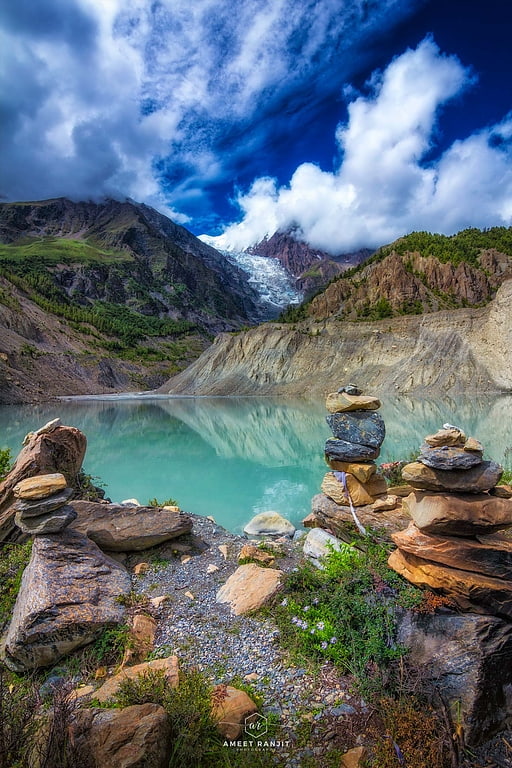
Gangapurna Lake is a glacial lake in Manang, Gandaki Province, Nepal. It was formed by glaciers from Mt Gangapurna, Annapurna IV, Khangsar Kang and Glacier Dom.[23]
Muktinath, Annapurna Conservation Area
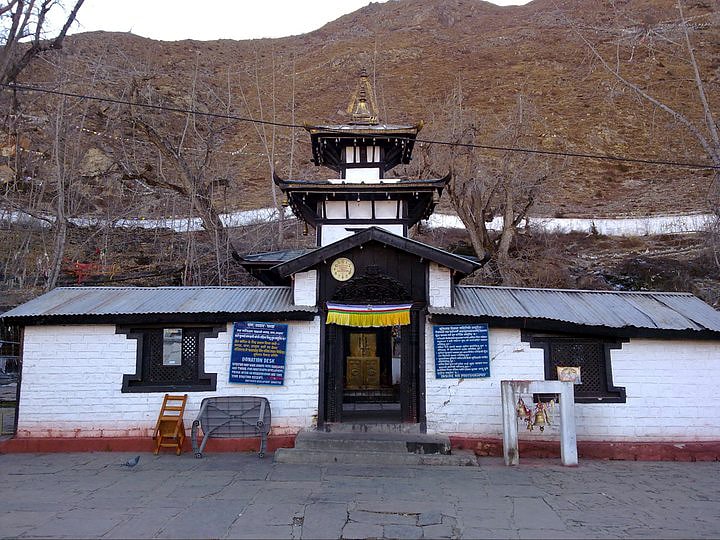
Also known as: मुक्तिनाथ
Hindu and Buddhist mountainside temple. Muktinath is a Vishnu temple, sacred to both Hindus and Buddhists. It is located in Muktinath Valley at the foot of the Thorong La mountain pass in Mustang, Nepal. It is one of the world's highest temples. Within Hinduism, it is one of the 108 Divya Desams, and is the only Divya Desam located outside India. It known as Mukti Kshetra, which literally means the 'liberation arena' and is one of the Char Dham in Nepal.
This temple is considered to be 106th among the available 108 Divya Desam considered sacred by the Sri Vaishnava sect. Its ancient name in Sri Vaishnava literature is Thiru Saligramam. The Gandaki river near by is considered the only source of the Saligram shila, considered to be the naturally available form of Sriman.
Buddhists call it Chumig Gyatsa, which in Tibetan means "Hundred Waters". For Tibetan Buddhists, Muktinath is an important place of dakinis, goddesses known as Sky Dancers, and one of the 24 Tantric places. They understand the murti to be a manifestation of Avalokiteśvara, who embodies the compassion of all Buddhas.
The site is close to the village of Ranipauwa, which is sometimes mistakenly called Muktinath.[24]
Chamlang, Makalu Barun National Park
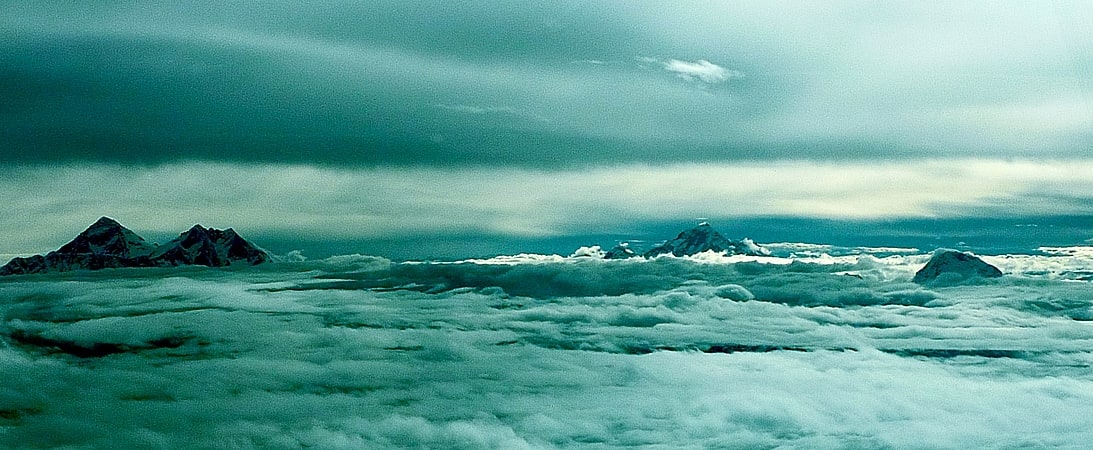
Mountain in Nepal. Chamlang is a mountain in the Nepalese Himalayas, near Makalu. It lies in the southern section of the Mahalangur subrange of the Himalayas. Chamlang has an elevation of 7,319 metres.
In 2021 a new, direct line up the sheer north face was climbed by two French mountain guides, Charles Dubouloz and Benjamin Vedrines. Climbing just as a pair, the route, which they named 'In the Shadow of Lies', took them four days to complete and included ice up to 90°.[25]